|
9.1 Objectives
This Lab contains 2 parts. In Part A, to be done in lab, you will:
- Create a geodatabase to contain existing data for the field area we
will visit this weekend;
- Create a feature dataset containing empty polygon, line and point
feature classes with domains for field data entry;
- Create a project containing all data needed for field data collection;
- Print layouts and instructions for data collection to take with you to the field;
- Export your project to an ArcPad v.10 project;
In Part B, to be done during the class lecture period you will:
- Learn procedures for capturing GPS points, lines and polygons with ArcPad
8 software;
- In pairs, use a Trimble Nomad GPS receiver to capture the
locations of polygons and lines on the East Campus Mall and
circle drive.
9.2 Geodatabase Preparation with ArcGIS 10.0
Most data for this project are available in shapefile format, but we will find
it useful to build a geodatabase so that we can
establish domains for data entry. We will be collecting data with ArcPad
software, which permits the capture of GPS positions for points and
vertices and uses forms for entering attributes while in
the field. By using coded value domains in our geodatabase, we can create drop-down menus for our forms, a far easier
way to enter attributes than pecking letters with a stylus on a virtual
keyboard. Recent versions of ArcPad (7.0 and above) also allow the option of
"checking out" Feature Classes from a database for field
editing with ArcPad, then checking them back in
when finished. When it works
properly, this is a very efficient way of editing a field-based GIS,
eliminating the need to update existing files by appending, merging or
otherwise editing them to conform to new field data. You have already done many of the steps
below in Lab 4. Refer to it if you've forgotten aspects
of geodatabase Feature Class and Domain creation.
- Download the Lab_8_data folder to your personal storage space.
- Open ArcCatalog and browse to your Lab_8_data folder.
- Create a personal geodatabase called "Mason_Mt_WMA" (= Wildlife Management Area)
within the Lab_8_data folder.
- Right-click on your new geodatabase and import all of the Feature Classes in the
Lab_8_data folder (and subfolders) into the geodatabase. The spatial reference for all of these feature
classes is NAD83, UTM zone 14N, and they will import as such.
- Geodatabases can not hold layer files (these files contain the symbology
for the feature classes you just imported) yet we would like to use the
layer files to symbolize the new geodatabase feature classes. To do so
we must reset the source for the layer files.
Right-click on a layer file icon, select "Properties...", click the
Source tab then the "Set Data Source..." button and reset the source by
browsing to the appropriate Feature Class in your geodatabase. Do this
for all Feature Class layer files (but not raster layer files).
- What about the raster files? The Lab_8_data folder contains two very high resolution DOQs (one multiband color, one single band panochromatic) and
a hillshade
raster with associated layer files; should we import these into the geodatabase? In
this case the disadvantages of doing so outweigh any advantage. In particular,
the color DOQ is a large MrSID file that would get much larger when uncompressed
and stored in IMG format, which is the format required by the geodatabase. There
is no real advantage to doing this, other than having everything in a single container,
and we are left with a file that is >150 Mb. We could instead create a geodatabase raster index (see
Help files on this topic), but for the few rasters we will work with this also provides no real advantage.
We will keep the rasters separate from the geodatabase for these reasons.
- Time to create the empty Feature Classes that will contain the GPS-derived
points lines and areas...
- Before doing so, it is good practice to create a Feature Dataset
that will contain the new Feature Classes (this is similar to creating a
feature dataset when we digitized in Lab 4; we are digitizing in the
field using a GPS instrument). To do so, right-click on the Mason_Mt_WMA geodatabase
icon, select "New...", then create a new Feature Dataset called "Geology".
SET THE SPATIAL REFERENCE OF THE FEATURE DATASET TO NAD83 UTM zone 14N,
SET THE "Z COORDINATE SYSTEM" TO <None>
AND ACCEPT THE DEFAULT XY TOLERANCES. (Note for outside users: the
procedure for doing this in ArcGIS 9.1 is somewhat different. See
an example here).
- Now we can create the Feature Classes; right-click on the Geology Feature
Dataset icon, select "New...", then create new Polygon, Line and Point
Feature Classes (named Polygon_XX, Line_XX and Point_XX, where XX is your
first and last initial). Do this step 3 times, one for each
Feature Class, being sure to change the Geometry type [polygon, line,
point] to match the Feature Class and checking the
Geometry Properties box on to allow "Coordinates include Z Values"
as shown below.
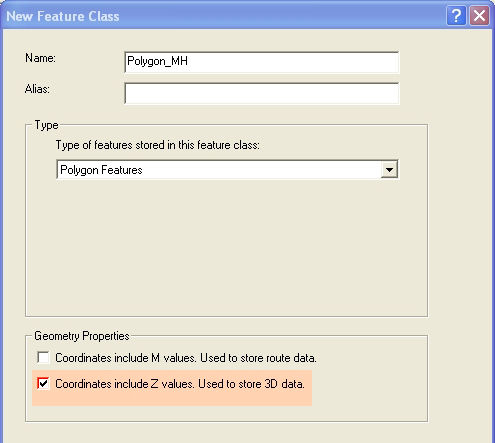
- The polygon feature class will be used to store the GPS-derived
outline of granite outcrops and any other features that are polygons. We need an attribute field that records
the feature being mapped (e.g. "granite", "pegmatite" or “other”) that can be
entered as we collect the data. So... add two Text fields to the polygon feature class, one called
"FEATURE" and another
called "COMMENT". The length of the FEATURE field should be 9 and the COMMENT field 30. Leave all other
Field Properties blank for now. Please use these precise field
names, including capitalization, for this and all other feature classes.
Merging and appending files from different GPS receivers is much easier
if everyone uses exactly the same field names
and properties.
- Create a Domain (by right-clicking on the Mason_Mt_WMA geodatabase icon, then Properties...) called
PLY_TYPE, (Field Type is Text) that is a coded-value domain containing the coded values of
"granite", "pegmatite", and "other" (see Lab
4) and then attach this domain to the polygon attribute field FEATURE
(again see Lab 4).
- The line Feature Class will be used to store rock unit contacts or
outcrop boundaries that can't immediately be seen to close on themselves
(i.e. can’t be mapped as polygons). The attributes that will be recorded and the new fields
to create are:
i. 9-character text field, called "FEATURE", that will contain coded values from a text Domain called
"LN_TYPE" of "contact",
"outcrop" and "other".
ii. 7-character text field, called "SYMBOL", that will contain coded values from a text Domain called
"Symbol" of "solid",
"dashed" and "dotted".
iii. 30 character text field, called "COMMENT", without an attached domain.
- Create these new Fields and their Domains with the above coded
values and attach the Domains to the Fields, as in steps c and f.
- The point Feature Class will be used to record the location of
features too small to recorded as polygons and for strike and dip
measurements. We will need fields for:
- 10-character text field, called "PT_TYPE", that will contain coded
values from a text Domain called "PT_TYPE" of "joint", "foliation",
"bedding", "dike" and "other".
- 3-character short integer field (Precision equals 3), called "STRIKE",
that will contain coded values from a short integer Domain called
"strike" of every third integers between 0 and 357 (i.e. Codes of 0, 3, 6, 9, 12
etc. with Descriptions of 000, 003, 006, 009, 012,
etc. to 357; yes, all 120 values).
- 2-character short integer field (Precision equals 2), called "DIP", that will contain
coded values from a short integer Domain called “dip” of every second
integer between 2 and 90 (i.e. Codes of 02, 04, 06, etc., with Descriptions
of 02, 04, 06 etc.; 44 values in all).
- 30-character text field, called "COMMENT", without an attached domain.
- Create these new Fields and their Domains with the above coded
values and attach the Domains to the Fields, as in steps c and d.
Congratulations, you have now completed the database you will need for
this project.
9.3 Making Field Maps
- Open ArcMap with an empty map document and load all of the LAYER FILES (not the Feature Classes),
including the layer files for the DOQ and Hillshade. If this doesn't
work, you skipped Step 5 above.
- Load your empty polygon_XX, line_XX and point_XX Feature Classes you just
created and move them to the top of the Table of Contents if not already
there.
- Order the remaining layers so that the Hillshade is at the bottom, the DOQ
is second from the bottom, and all remaining layers above these.
- Set the Display Properties of the rock units and the
outcrop polygons to 50% transparent.
- Zoom to the WMA boundary layer, reset the reference scale, and
SAVE THE MAP document to your Lab_8 folder.
Switch to Layout mode and make a map with a 50 meter UTM grid, scale bar, north arrow, name, etc. Print two maps, one with the hillshade layer turned on and another with the hillshade off
but the DOQ on. The scale should be ~ 1:10,000 to be useful; you will have
to tile the map onto a few pieces of paper to cover the area of interest
(Julio will tell you how much of the area to print), which is within the portion of the WMA
that is within granite southeast of Mason Mountain and along the western
boundary within granite.
Bring these maps with you on the field trip.
9.4 Trimble Nomad and ArcPad v. 10
GPS data collection using the Trimble Nomad units is done with ArcPad software. ArcPad is a streamlined version of ArcGIS
that is equipped with very easy to use GPS capture tools. ArcPad 10 is
installed on the classroom computers and our field data collection units. Version
10 is a major revision
from earlier releases. Before getting a little ArcPad
practice, we first need to convert the ArcGIS map document file into an
"ArcPad Project". An automated tool exists to do so, which converts
most rasters to jpeg images, the geodatabase to an ArcPad exchange format
database (.AXF),
and makes data entry forms from the domains for each Feature Class.
We can "check out" the empty Feature Classes for editing then, upon
return, "check in" the same, permitting the software to automatically
update the geodatabase!
An important note about ArcPad versions:
- ArcPad 10 represents a significant departure from earlier
versions (i.e. 8.x and below). "ArcPad Projects" created for ArcPad
10 will not run on 6.x software, and vice-versa.
The ArcMap toolbar for creating ArcPad projects in versions of
ArcGIS 9.1 and higher contains separate tools for creating ArcPad 8.x and 6.x (or lower) projects. It is thus important to know
which version of ArcPad is installed on your field data collection
units. Our Trimble Nomads and Xplore tablet PCs are
currently running ArcPad 10, as are
the computers in the lab.
A. Preparing the Map Document for ArcPad (version 10).
- Open your map document.
- Switch to Data View mode (if you're in Layout mode) and zoom to the
WMA_boundary layer. This is an important step!
- Make sure the "Point_XX", "Line_XX" and "Polygon_XX"
Feature Classes
are present in the Table of Contents of the map. These are empty, but have coded-value domains already
built that will allow use of ArcPad data entry forms. These are
the files you will populate with GPS measurements.
- Change the symbology of these files to colors/symbols that will
be recognizable on both a white background and the DOQ. Red works
well, as does light blue. This is much easier to do now than later
in ArcPad.
- If not already on. Turn on the ArcPad Data Manager
toolbar (Tools>customize...) shown below.
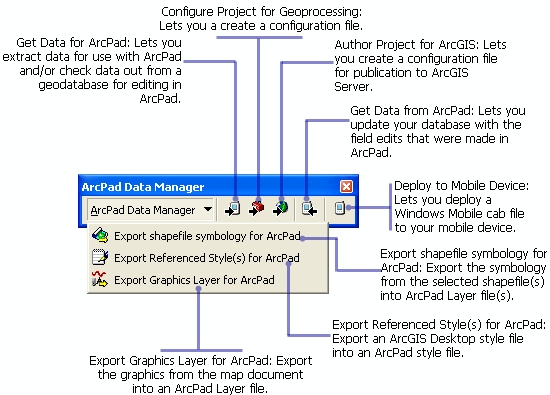
- On the ArcPad toolbar, click the "Get Data for ArcPad" button.
In the "Select Data"
window, shown below, there are several options for how to export data
under the "Action" column. The "action" performed
on each layer can be set individually or for all layers
by clicking on the word "Action" to display the menu
shown in the figure below. Strictly speaking, we
can either "Checkout" a layer for editing or "Copyout" a
layer. A "Checkout" is only allowed for Geodatabase
layers; shapefiles or other layers not in a geodatabase
can be "Copied Out". A "Checkout" creates a compact
geodatabase that can only be read by ArcPad in a so-called "AXF"
(Arc Pad Exchange Format) file. There are
numerous advantages to AXF files - read about them on
page 573 of the ArcPad Help PDF in the Lab 8_data
folder. For our purposes, the principal advantage
is the automatic creation of forms (based on our geodatabase domains)
that can be edited in the field, and the ability to directly import the
results into our ArcGIS project after returning from the field.
The main disadvantage is that a Checkout is tied to a specific ArcGIS
file, your project, on a specific computer. After data
collection, the file can only be checked into your
project (into your
geodatabase) on the computer you created it on. An AXF file can
not be edited by any software, so if you are unable to check it back in,
for whatever reason, you've lost all of your field results.
The other option, "Copyout", creates a Shapefile that can be read by ArcPad. Unfortunately, this option does not automatically create
forms for field editing, nor can results be directly checked back into
your ArcGIS file after field work is done. The shapefiles can,
however, be downloaded from the receiver onto a computer and loaded into
your ArcGIS project by the same process you would use to load any other
shapefile. "Copyout" layers are exported to ArcPad as "background
layers" that either can be editable or not.
We will cover several bases by "Checking Out" the three files we will
edit in the field (Point_XX, Line_XX, Polygon_XX), "Copyout" the
"Outcrop-Lines_sample" layer as an editable background shapefile, and "Copyout"
all other files (those we will not edit) as "read-only" background
shapefiles. I will explain the rationale during lecture. To
do this requires specifying the "action" for each layer individually.
- Click the black arrowhead to the left of your "Line_XX"
Layer and choose "Checkout for disconnected editing in ArcPad>data based
on defined extent". Do the same for the Point_XX and Layer_XX
layers.
- For the "Outcrop_lines_sample" layer, choose the
action "Export as background data>Make Editable.
- For all other vector layers choose "Export as Background data (to
AXF layer)>Make Read Only"
- Do not export the raster files.
- Click Next.
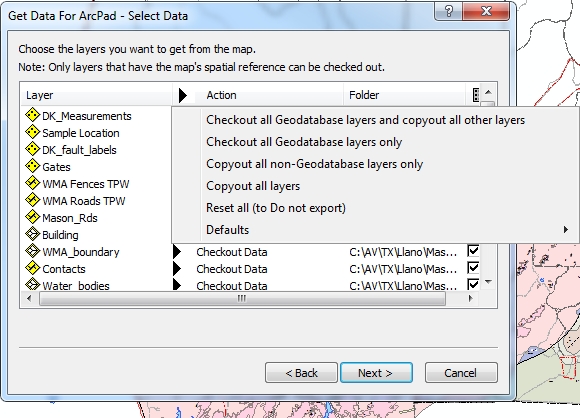
- The next window, "Select Picture Options", is not
applicable to this project; Click Next.
- The final window lets you set the spatial extent (current
display extent or full extent of the layers), lets you select whether to
limit the fields to those that are visible in the attribute tables and
the features to those specified in the layer's definition query, lets
you specify a name for the folder that will store the data, and lets you
create an ArcPad map file (the equivalent of an .mxd file) for the data,
as shown in the "Get Data For ArcPad" screen capture below.
- Enter a name for the folder, e.g. "ArcPad_WMA_XX" (where
XX are your initials) and a
Map Name that includes your last name or initials (e.g. WMA09_XX).
- Making sure first that your display shows the entire area of
interest (i.e. you are zoomed to the WMA boundary layer), make the selections shown in the figure below, setting the
"Where do you want the folder to be stored?" to an appropriate location
on your network storage space.
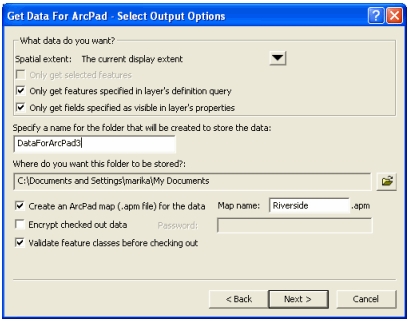
- Click Finish and wait for the data to be created.
- With help from Julio, transfer your new "ArcPad_RR_XX" folder
to your Trimble Nomad (these will be shared, but each partner can load a
project). The Nomad units have a folder called "My
Documents" that should be used for all ArcPad
data and files.
- Print a color copy of the PDF file "ArcPad Quick Reference", in color,
from All Programs>ArcGIS>ArcPad 10>Help>ArcPad Quick Reference.
You will find this exceptionally useful for Part B of this lab, and for
the field trip.
Part B: Practice with ArcPad in the field
9B.1 Using ArcPad - some practice with the basics
Editing in ArcPad is, in most ways, much simpler than Editing in ArcGIS.
The basic concept is the same in both - data are entered into a file that
is open for editing. Below are a few of the basics. A complete description of the
software can be found in the ArcPad 10 folder in the class folder.
- On a classroom computer, open ArcPad 10 from the Start Button>All Programs menu in Windows.
- Click the folder button at the top of the ArcPad window and select
"Open Map", then browse to your ArcPad map file, the one with
the ".apm" extension, in your "ArcPad_RR_XX" folder.
- Five toolbars are immediately available (called Main
Tools, Browse Tools Edit Tools Quick Capture and Navigation), though
only one at timeis displayed (this saves real estate on small
screens).
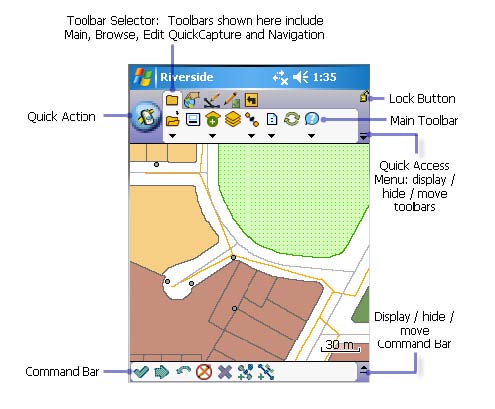
- Click the Main Tools icon (on the left in the figure above) and then
select the Layers icon
 to
open up a Table of Contents, like that on the left below. The
diagram on the right, from an earlier version of ArcPad, has many of the
icons labeled. to
open up a Table of Contents, like that on the left below. The
diagram on the right, from an earlier version of ArcPad, has many of the
icons labeled.
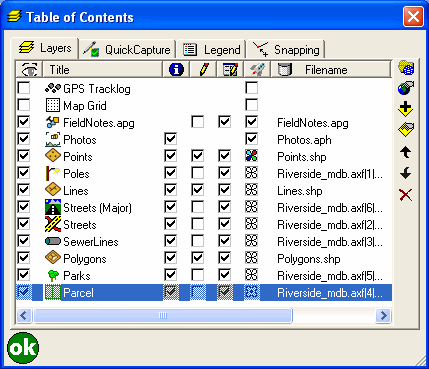 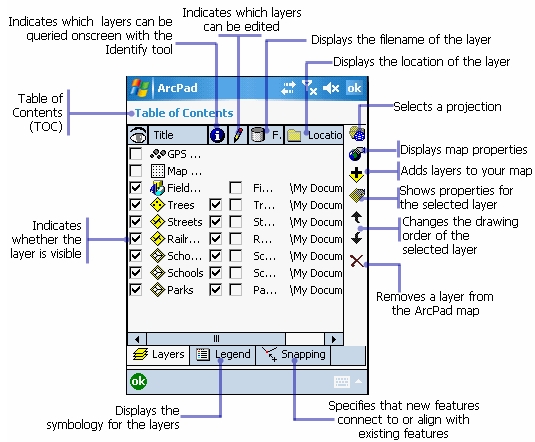
-
The check boxes on the left in the "eye" column turn
layers on and off for viewing. The check boxes in the "pencil"
column turn layers on and off for editing. This is similar
to setting the "Target" of the editing toolbar in ArcGIS, except that
in ArcPad more than one layer can be open for editing at a time. In
the Table of Contents to the right above, none of the layers are open for
editing. In the table of contents on the left above three layers
(Point, Line, Polygon) are open for editing. Finally, the check boxes below the Info icon (i) make layers available for query.
Layer Properties can be accessed by an icon on the right, as can other
options denoted by icons that should be familiar from ArcMap. The
column with the "rocket ship" icon at the top is the QuickDraw mode;
checking boxes here allows the different layers to be drawn to different
"coarseness" so they will render quicker on screen. The QuickDraw
mode is accessed from the Editing Toolbar.
-
Turn on the "Point_XX" layer for editing and close the
Table of Contents.
-
Turn on the Edit toolbar by selecting it from top row of
icons, as shown below.
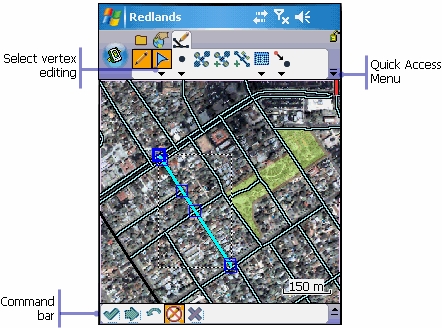
-
The function of the edit tools are shown in the figure
below. This is the most important toolbar for the field work
this weekend. Learn it.
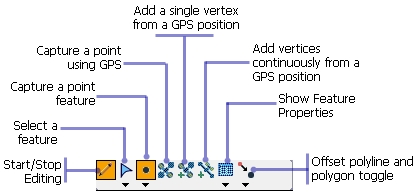
To add a point to the map, Click the pencil tool, select
the layer you want to edit, click the "Capture a point
feature" button, (Capture of polyline or polygon features, if open
for editing in the TOC, can be selecting from the drop-down menu below
the "capture a point" feature icon). Then click a location on the map. A data entry form should then open,
allowing you to select the feature name from a drop down list.
To do outdoors: To add a GPS location as a point, click instead the
"Capture a point using GPS" button. (When the GPS is active this
button is not grayed-out.)
-
To add a line, click the Pencil icon, select the polyline
feature class you want to edit, click the drop-down arrow below
to the "Capture a point feature" button, and select "Polyline".
Click on the map where you wish to place a polyline vertex, click and drag
on the next spot where you want a vertex, and continue this process until
finished. The line is not completed until you click the "Proceed
or complete feature" button at the bottom of the ArcPad window
(shown below).

-
To do outdoors: To add GPS vertices to a polyline, as above, click the "Capture a polyline"
button (beneath the capture a point button), click the "Add a single
vertex from a GPS position" button and continue clicking this button
every time you want to add a vertex to the line. To finish the
line, click the "Proceed or complete feature" button, the
green arrow icon. The line is not completed until you click the
"Proceed or complete feature" icon.
The GPS must be activated before
the GPS buttons are available.
-
A similar procedure is used to capture polygon vertices
with and without GPS.
-
You can delete features by selecting them with the
Arrow button (shown above) and then
clicking the "Edit vertices" button.
-
Practice adding and deleting lines, points and polygons to the map.
Name the features test1, test2, etc. so that, if needed, you will be able to recognize and
delete them later.
-
Browse the ArcPad manual in the digital books folder,
particularly the sections on editing. Download and print the
ArcPad Quick Reference
page.
-
Before loading your WMA ArcPad folders to the field GPS
units, clear each of your test features, or don't save your project after
editing.
9B.2
-
Before our field trip, you need practice using ArcPad with a GPS.
An ArcPad project for the Main Building area, identical to the ArcGIS project
you constructed in Lab 6, is loaded on all instruments. Take
your instrument outside, open the Main Building project, and practice
capturing lines, points and polygons using the ArcPad GPS
tools described above.
-
Specifically, capture the features listed and
labeled in the photo below.
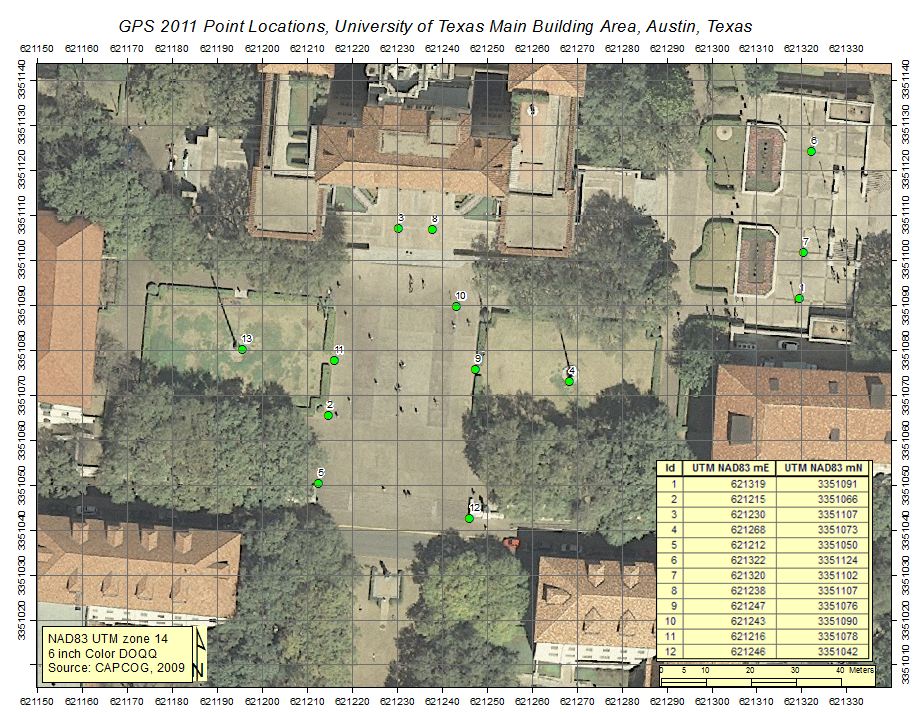
- Points: Points at the two flagpoles.
- L1, L2, L3: Polylines with at least 3 GPS vertices at the edges of
sidewalks.
- P1, P2: Polygons outlining grass areas - capture the vertices
of the 4 corners with
GPS.
You're done.
|
 |